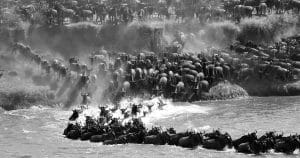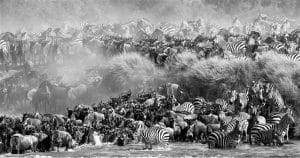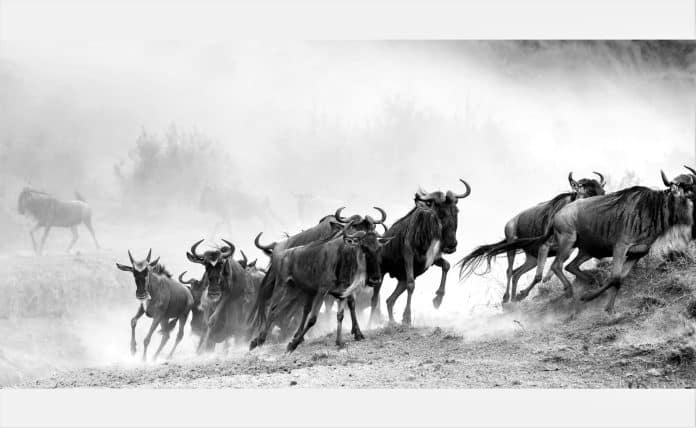The Great Wildebeest Migration: Witness the Spectacle in Kenya and Tanzania
Experience the most incredible animal migration on the planet – the Great Wildebeest Migration, as it unfolds across the plains of Kenya and Tanzania. This awe-inspiring spectacle involves millions of wildebeest, zebras, and gazelles traversing vast distances in search of greener pastures and water sources. It’s a display of nature’s incredible power and resilience that has captivated travelers and wildlife enthusiasts for generations.
From the endless plains of the Serengeti to the iconic Maasai Mara, witness the epic journey of these magnificent creatures as they conquer treacherous river crossings, brave predatory attacks, and embark on a cycle that has lasted for centuries. Catch a glimpse of their thundering hooves, hear their resonant calls, and feel the ground shake beneath you as the herds advance in unison.
Whether you choose to witness this extraordinary event from a hot air balloon, a 4×4 safari vehicle, or on foot with a knowledgeable guide, the Great Wildebeest Migration promises an experience like no other. Prepare to be immersed in the raw beauty and drama of nature as you witness this remarkable animal migration in Kenya and Tanzania unfold before your eyes. Don’t miss your chance to be a part of this once-in-a-lifetime adventure.
The Route of the Migration

The animal migration Kenya Tanzania also known as the Great Wildebeest Migration is a circular journey that takes place between the Serengeti National Park in Tanzania and the Maasai Mara National Reserve in Kenya. The journey covers a distance of approximately 1,800 miles as the herds move in search of fresh grazing lands. The migration is influenced by the availability of water and food, as well as the changing seasons.
The migration begins in the Serengeti around December-January, as the herds start their journey towards the southern plains. They graze and give birth to their young in the calving season, which takes place from January to February. As the dry season approaches, the herds move towards the western corridor of the Serengeti, crossing the Grumeti River in search of water.
From the western corridor, the wildebeest continue their journey northwards, crossing the Mara River into the Maasai Mara in Kenya. This river crossing is one of the most dramatic and dangerous parts of the migration, as crocodiles lie in wait for their prey. The wildebeest spend the months of July to October in the Maasai Mara, before starting their journey back to the Serengeti as the rainy season approaches.
Timing the Migration – When and Where to Go
To witness the Great Wildebeest Migration, timing is crucial. The animal migration in Kenya and Tanzania is a continuous cycle, but the exact timing can vary depending on the weather patterns and the availability of food and water. Generally, the best time to witness the migration in Kenya is between July and October when the herds are in the Maasai Mara. In Tanzania, the best time is from December to February when the herds are in the southern plains of the Serengeti.
During these months, the herds gather in massive numbers, creating a spectacle that is truly unforgettable. The river crossings, in particular, are a highlight of the migration. Watching thousands of wildebeest and zebras navigate through crocodile-infested rivers is a sight that will leave you in awe of nature’s power.
To increase your chances of witnessing a river crossing, it is recommended to spend at least a few days in the Maasai Mara or the Serengeti. Patience is key, as the timing of the crossing can be unpredictable. However, with the help of experienced guides and local knowledge, you can position yourself in the right place at the right time to witness this incredible event.
The Wildebeest and Their Behavior During the Migration
Wildebeests are known for their nomadic nature and their ability to adapt to changing environments. During the animal migration in Kenya and Tanzania, these incredible animals showcase their resilience as they face numerous challenges along their journey.
The wildebeest are constantly on the move, driven by the need to find fresh grazing lands. They move in massive herds, consisting of hundreds of thousands of individuals, creating a spectacle that is unmatched anywhere else in the world. The herds are led by the dominant males, who navigate the migration routes based on their collective memory and instincts.
Throughout the animal migration Kenya Tanzania, the wildebeest face various threats, including predators such as lions, cheetahs, and hyenas. The predators take advantage of the abundance of prey, targeting the young and weak individuals. The wildebeest, however, have developed strategies to protect themselves. They form tight-knit groups, known as “rafts,” which provide safety in numbers. The herds also have a synchronized birthing pattern, which ensures that a large number of calves are born at the same time, increasing their chances of survival.
The wildebeest also plays a crucial role in the ecosystem. Their constant movement and grazing help maintain the balance of the grasslands. By eating the older grass, they stimulate new growth and prevent the area from becoming overgrown. This benefits not only the wildebeest themselves but also other herbivores and the predators that depend on them for food.
Other Animals to See During the Migration

While the wildebeest are the stars of the show during the Great Wildebeest Migration, they are not the only animals you will encounter. The migration attracts a wide variety of other wildlife, creating a diverse and dynamic ecosystem.
Zebras, often seen grazing alongside the wildebeest, form a symbiotic relationship with them. Zebras have a keen sense of smell and can detect predators from a distance. By sticking close to the wildebeest, they benefit from their superior hearing and ability to detect danger. This mutually beneficial relationship ensures the survival of both species.
Gazelles, both Thomson’s and Grant’s, also join the migration, adding to the spectacle. These graceful antelopes can be seen bounding through the grasslands, their speed and agility allowing them to keep up with the wildebeest and zebras.
Predators are never far behind, taking advantage of the abundance of prey. Lions, the iconic kings of the savannah, are a common sight during the migration. They often target the young and weak individuals, but witnessing a successful lion hunt is a rare and thrilling experience.
Cheetahs, the fastest land animals, are also present during the migration. They use their incredible speed and agility to chase and capture their prey. Seeing a cheetah in action is a sight that will leave you in awe of nature’s design.
Best Places to Witness the Migration in Kenya
In Kenya, the Maasai Mara National Reserve is the best place to witness the Great Wildebeest Migration. The Maasai Mara is an extension of the Serengeti ecosystem and provides a crucial stopover for the herds during their journey. It offers vast open plains, dotted with acacia trees and water sources, providing the perfect habitat for the wildebeest and other wildlife.
The Mara River, located within the Maasai Mara, is where the most dramatic river crossings take place. It is a focal point of the migration, attracting large crowds of wildebeest and zebras. Positioning yourself near the riverbanks during the months of July to October will increase your chances of witnessing this incredible event.
The Maasai Mara offers a range of accommodation options, from luxury lodges to tented camps. Some lodges are strategically located near the river crossings, ensuring that you are in the heart of the action. These lodges often have elevated viewing decks, allowing you to observe the migration from a comfortable and safe distance.
Best Places to Witness the Migration in Tanzania
In Tanzania, the Serengeti National Park is the main stage for the Great Wildebeest Migration. The Serengeti is a UNESCO World Heritage Site and one of the most iconic wildlife destinations in Africa. It is home to vast grasslands, rocky outcrops, and tree-lined rivers, providing a diverse and breathtaking landscape.
The southern plains of the Serengeti are where the wildebeest give birth to their young during the calving season. Witnessing the newborn calves take their first steps is a heartwarming experience. The large number of predators in the area adds to the drama, as they patiently wait for an opportunity to strike.
The western corridor of the Serengeti is another hotspot for the migration. This is where the herds cross the Grumeti River, facing the danger of crocodiles lurking beneath the surface. The river crossings in the western corridor are not as crowded as those in the Maasai Mara but offer a unique and equally thrilling experience.
Accommodation options in the Serengeti range from luxury lodges to mobile tented camps. Mobile camps are set up in strategic locations to follow the migration, ensuring that you are always close to the action. These camps provide a more immersive experience, allowing you to truly connect with nature and the wildlife around you.
Accommodation Options for the Migration
Choosing the right accommodation is crucial when planning your animal migration in Kenya and Tanzania safari exploration. There are a variety of options available, ranging from luxury lodges to tented camps, each offering a unique experience.
Luxury lodges provide the utmost comfort and luxury, often featuring spacious rooms, private decks, and gourmet dining. These lodges are designed to blend seamlessly with their natural surroundings, offering stunning views of the landscape. They often have swimming pools, spa facilities, and other amenities to ensure a relaxing and indulgent stay.

Tented camps, on the other hand, provide a more authentic and immersive experience. These camps consist of spacious and comfortable tents, complete with en-suite bathrooms and hot showers. They are often located in remote and exclusive areas, allowing you to connect with nature and the wildlife around you. Some camps also offer private guides and personalized safari experiences, ensuring that your stay is tailored to your preferences.
For those seeking a more adventurous experience, mobile tented camps are an excellent option. These camps are set up in strategic locations to follow the migration, allowing you to be in the heart of the action. They offer a truly immersive experience, as you sleep under canvas and wake up to the sounds of nature. Mobile camps are often equipped with comfortable beds, hot showers, and delicious meals prepared by skilled camp chefs.
Tips for Planning Your Migration Safari
Planning a Great Wildebeest Migration safari requires careful consideration to ensure a memorable and successful trip. Here are some tips to help you make the most of your experience:
- Choose the right time: Research the best time to witness the animal migration in Kenya and Tanzania, depending on your preferences and availability. Consider the river crossings and the availability of predators for a more dramatic experience.
- Book accommodation in advance: The Great Wildebeest Migration attracts a large number of visitors, so it’s important to book your accommodation well in advance. This will ensure that you secure a spot in a lodge or camp of your choice.
- Pack appropriate clothing: The weather can vary during the migration, so pack layers to accommodate changing temperatures. Opt for neutral colors to blend in with the surroundings and bring a hat, sunscreen, and insect repellent.
- Choose the right safari vehicle: If you opt for a 4×4 safari vehicle, choose one with a pop-up roof for better visibility and photographic opportunities. Ensure that the vehicle is well-maintained and equipped with the necessary safety features.
- Engage a knowledgeable guide: A knowledgeable guide can enhance your safari experience by providing valuable insights and information about the migration and the wildlife. They can help you position yourself in the right place at the right time for the best sightings.
- Respect the wildlife: Remember that you are a guest in their natural habitat. Maintain a safe distance from the animals, follow your guide’s instructions, and never feed or disturb the wildlife.
- Capture the memories: Bring a good camera with a telephoto lens to capture the incredible moments of the migration. Practice your photography skills beforehand to make the most of your opportunities.
Why the Great Wildebeest Migration Is a Must-See Spectacle
In conclusion, the animal migration Kenya Tanzania is a natural phenomenon that should be on every traveler’s bucket list. Witnessing millions of wildebeest, zebras, and gazelles on their epic journey across the plains of Kenya and Tanzania is an experience like no other. From the thundering hooves to the dramatic river crossings, the migration showcases the power and resilience of nature.
Whether you choose to witness the migration from the Maasai Mara in Kenya or the Serengeti in Tanzania, be prepared for an adventure that will leave you in awe. The migration is a spectacle that has captivated travelers and wildlife enthusiasts for generations, and it continues to inspire and amaze.
So pack your bags, prepare your camera, and embark on a journey to witness the Great Wildebeest Migration. Immerse yourself in the raw beauty and drama of nature, and create memories that will last a lifetime. Don’t miss your chance to be a part of this incredible spectacle – a true testament to the wonders of the natural world.
For more articles related to Things to Do in Tanzania (Zanzibar), click here!


































